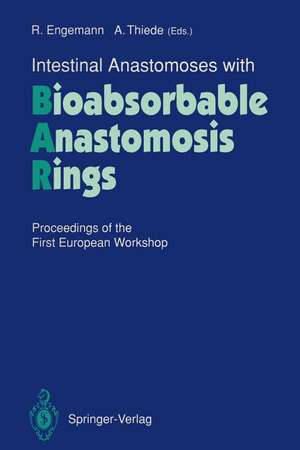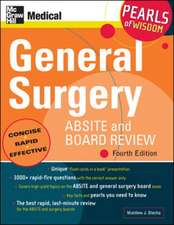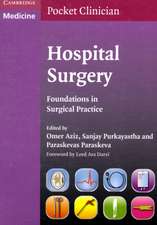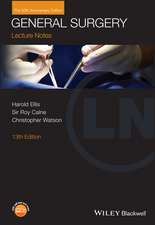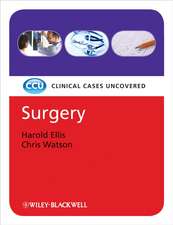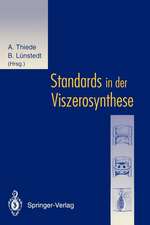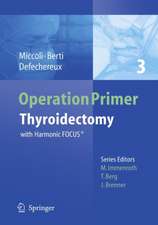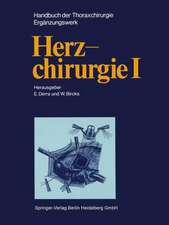Intestinal Anastomoses with Bioabsorbable Anastomosis Rings: Proceedings of the First European Workshop
Editat de Rainer Engemann Contribuţii de J.-E. Akerlund Editat de Arnulf Thiede Contribuţii de B. Brismar, C. J. Cahill, M.R. Christiaens, W. Coosemans, S. Debus, W. Dietz, J.A. Gruwez, T. Havia, J. Lerut, L. Lim, B. Lünstedt, W. Mokros, M. Philippe, G. Schindler, W. Schmitz, J. Verbruggen, L. Verougstraete, S. Vogel, I. De Weveren Limba Engleză Paperback – 22 mar 1993
Preț: 705.68 lei
Preț vechi: 742.82 lei
-5% Nou
Puncte Express: 1059
Preț estimativ în valută:
135.05€ • 140.47$ • 111.49£
135.05€ • 140.47$ • 111.49£
Carte tipărită la comandă
Livrare economică 12-26 aprilie
Preluare comenzi: 021 569.72.76
Specificații
ISBN-13: 9783540563402
ISBN-10: 3540563407
Pagini: 112
Ilustrații: XI, 96 p. 30 illus.
Dimensiuni: 155 x 235 x 6 mm
Greutate: 0.17 kg
Editura: Springer Berlin, Heidelberg
Colecția Springer
Locul publicării:Berlin, Heidelberg, Germany
ISBN-10: 3540563407
Pagini: 112
Ilustrații: XI, 96 p. 30 illus.
Dimensiuni: 155 x 235 x 6 mm
Greutate: 0.17 kg
Editura: Springer Berlin, Heidelberg
Colecția Springer
Locul publicării:Berlin, Heidelberg, Germany
Public țintă
ResearchDescriere
The anastomotic technique plays a predominant role in gastrointestinal surgery. A feared complication is leakage due to the sutures. Such leakage cannot be detected early; consequently, infection spreads locally and systemically. An anastomotic method is generally evaluated according to its rate of leakage, related to the localization, bur real scientific comparisons, i.e., controlled studies, are almost totally lack ing. The criteria of evaluation include the type of suture, the localization, the auxiliary technical tools, practicability, the different forms of wound healing, angiogenesis, and vascularization, among others. The postoperative criteria are complications shortly after surgery, such as bleeding, ruptures, and stenoses of the anastomosis. A standard comparison is made difficult by the variety of cytophysiological and biochemical factors that influence wound healing. In the comparison of larger series one must always take into account differences of auxiliary tools, strategies, and inhomogeneity of patients. A change of one auxiliary tool or of one strategy implies the modification of various target criteria. Often enough, however, one does not sufficiently consider the surgeon's most. important role.
Cuprins
General Aspects of Bioabsorbable Ring Anastomoses with Valtrac.- The Healing Process of Anastomoses with Bioabsorbable Rings: An Experimental Study in Pigs.- The Application of Special Instruments with the Bioabsorbable Anastomosis Ring: Technology and Technical Aspects.- Standardized X-Ray Examination of the Bioabsorbable Ring Anastomosis.- Clinical Application of the Bioabsorbable Anastomosis Ring in Gastrointestinal Surgery I.- Multicentre European Prospective Randomized Trial of the Valtrac Bioabsorbable Anastomosis Ring.- Prospective Trial of the Bioabsorbable Anastomosis Ring in Gastrointestinal Surgery.- Prospective Study of Results and Complications in 304 Bioabsorbable Ring Anastomoses in the Upper and Lower Gastrointestinal Tract.- Clinical Application of the Bioabsorbable Anastomosis Ring in Gastrointestinal Surgery II.- Occlusion Ileus Due to Blood Clots Following Right Hemicolectomy: A Rare Complication.- Experience with the Bioabsorbable Valtrac Ring in Small and Large Bowel Anastomoses.- Intestinal Anastomoses with the Aid of Bioabsorbable Rings: The Swedish Experience.- Clinical Experience with the Bioabsorbable Anastomosis Ring in Bowel Surgery.- Multiple Application of the Bioabsorbable Anastomosis Ring in Gastrointestinal Surgery.
